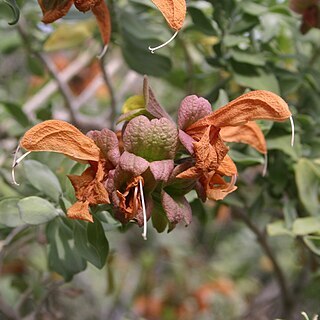Much branched shrub up to 2 m tall; stems densely leafy, sparse to densely appressed white-tomentose, dotted with orange-red gland-dots. Leaves petiolate; blade simple, thickish or thin-textured, suborbicular to elliptic or narrowly obovate, 15-35(-55) x 6-20(-40) mm, grey-tomentose, gland-dotted, apex rounded to obtuse, base cuneate to cordate or shortly lobed, margin usually entire but sometimes crenate-dentate to eroso-crenate(the larger leaves); petiole 2-15 mm long. Inflorescence simple, usually dense, of 3-12 verticils; verticils 2(-4)-flowered; bracts broadly ovate or obovate, persistent. Calyx broad-campanulate, expanding to 30 mm long in fruit, purplish and membranous, with short spreading glandular and eglandular hairs, dotted with orange-red gland-dots. Corolla golden brown, reddish brown, khaki or occasionally purplish, (30-)35-45(-50) mm long; tube c. 20 mm long, upper lip c. 25 mm long, slightly falcate; lower lip c. 12 mm long.
Much-branched shrub, 0.6-2.0 m high; stems densely leafy; sparsely to densely white-tomentose, gland dots orange. Leaves petiolate, blade simple, suborbicular to elliptic or narrowly obovate, 15-35 x 6-20 mm, base cuneate to cordate, apex rounded to obtuse, margins Sub-Entire to crenate-dentate to eroso-dentate in larger leaves; thickish or thin-textured, grey-tomentose, gland-dotted. Inflorescence simple, dense; verticillasters 3-12, spaced, each 2(-4)-flowered; bracts broadly ovate or obovate. Flowers golden-brown, reddish brown or khaki to purplish. Calyx broadly campanulate, expanding to 30 mm long in fruit. Corolla: tube ± 20 mm long; upper lip ± falcate; lower lip ± 12 mm long. Flowering time July-Jan.

